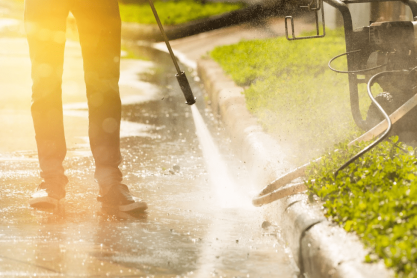
The terms pressure cleaning and power washing are often interchanged to mean the same thing, however there are significant differences between the two cleaning methods.
Pressure Pumps NQ offers the best, customised pressure cleaning and power washing solutions in North Queensland and we are commonly asked what is the difference between the two, and how they compare along with soft washing.
Power washing is the most aggressive form of cleaning whereIn power washing, water is either pressurised to a high level using a specialised machine or heat is used in the cleaning process. The high-pressure water jet acts as a strong abrasive, which effectively removes the accumulated dirt and grime from surfaces. Heat is further ammunition to loosen hard contaminants such as oils and greases.
Power washing is also a popular choice for preparing surfaces for painting or refinishing. By removing dirt, grime, and old paint, power washing helps to create a clean and smooth surface for new paint or coatings to adhere to. It’s also commonly used to clean up after construction projects, as it can remove concrete residue, paint splatters, and other debris.
This form of cleaning is best left for the professionals. The high-pressure water jet can be dangerous if not handled correctly and has the potential to cause serious harm along with structural damage when used by an untrained operator.
Pressure washing is a cleaning method that uses high-pressure water to remove dirt, grime, and other buildup from surfaces. It’s similar to power washing in that it uses high-pressure equipment, but it operates at an average temperature and does not heat the water.
The pressure in pressure washing can range from 1300 to 44000 psi, which makes it ideal for cleaning surfaces that require a decent high level of pressure but not necessarily heat. It’s also versatile, as a variety of nozzles can control the pressure, making it suitable for different cleaning tasks.
One of the advantages of pressure washing is that it’s effective in cleaning a wide range of organic materials, including algae, moss, and mildew, from surfaces like stone or driveways. It’s also useful for cleaning outdoor furniture, patios, and decks, as well as preparing surfaces for painting or refinishing.
Soft washing is a low-pressure cleaning technique that uses a combination of soap or cleaners and low-pressure water to clean surfaces. It is an eco-friendly method that uses less power and no hot water.
Soft washing is ideal for surfaces like wood or vinyl because it preserves protective coatings. The pressure applied in soft washing is simply a means of applying the chemical solution to the surface. In softwashing, chemicals do all of the work.can be adjusted by using a wider pressure washer tip that can lower the applied pressure to 500 psi, and adjusting the pound-force per square inch on the machine can further reduce the pressure.
Choosing the right type of washing technique is important to achieve optimal results while also protecting the surfaces being cleaned. Understanding the different types of washing and when to use them can make a significant difference in the outcome.
Power washing: The most powerful cleaning method and is ideal for removing heavy buildup and dirt from tough surfaces such as ship hulls, mining and earthmoving machinery, driveways, stone walls, and rough concrete. It’s also effective in sanitising these surfaces, making it a popular choice in commercial and industrial settings.
Pressure washing: A versatile method that can be used to clean walking surfaces, driveways, decks, stone pathways, and patio furniture. It’s also a great choice for surfaces that require less pressure, such as painted surfaces and delicate materials like wood or plastic. Pressure washing is an effective way to remove dirt and buildup from surfaces that don’t require the high-pressure cleaning of power washing.
Soft washing: The gentlest cleaning method and is the best technique for surfaces like stucco, vinyl siding, cedar shake siding, wood panel siding, outdoor wood furniture, outdoor rooted plants, screens, enclosures, and patioslanais. It’s a low-pressure method that uses a cleaning solution to remove dirt and buildup from surfaces while preserving the protective coatings. Soft washing is an ideal choice for surfaces that can be easily damaged by high-pressure washing.
For residential and commercial buildings, pressure washing is ideal for cleaning exterior facades, sidewalks, stairways, walkways, patios, and driveways. In addition, public spaces like stadiums, open-air plazas, and parking garages can benefit from pressure washing to keep them clean and well-maintained.
Vehicles of all types, including cars, buses, trucks, and boats, can also benefit from pressure washing. This is because pressure cleaning can effectively remove dirt and grime that builds up over time, helping to maintain the vehicle’s appearance.
Using a pressure cleaner is one of the most cost-effective ways to give a building a facelift while keeping properties clean on a regular basis. Even private homeowners can use a pressure cleaner to spruce up their place and maintain its value. Pressure washing is a versatile and effective method that can be used in a variety of applications, making it an essential tool for many cleaning projects.
In conclusion, understanding the differences between power washing, pressure washing, and soft washing is crucial in determining the right cleaning technique for your needs. Each method has its advantages and works best for specific surfaces.
Contact Pressure Pumps NQ on (07) 4041 0006 for the best techniques and services for your requirements. We offer a range of high-pressure cleaning services including customised solutions for all applications in North Queensland.
Monday
Tuesday
Wednesday
Thursday
Friday
Saturday
Sunday
Public Holidays
7:30am – 4:00pm
7:30am – 4:00pm
7:30am – 4:00pm
7:30am – 4:00pm
7:30am – 4:00pm
Closed
Closed
Closed